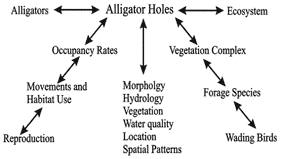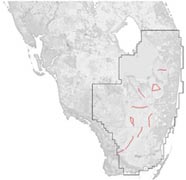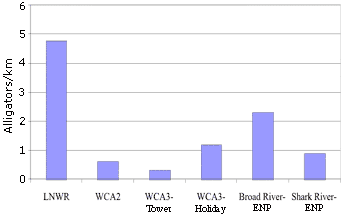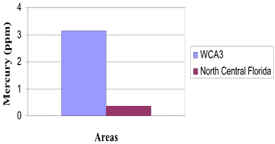Role of American Alligator (Alligator mississippiensis) in Measuring Restoration Success in the Florida Everglades
Poster presented April 2003, at the Greater Everglades Ecosystem Restoration Conference
Frank J. Mazzotti1, Kenneth G. Rice2, Laura A. Brandt3, Clarence Abercrombie4, Christa Zweig1, Michael S. Cherkiss1, Mark W. Parry1
[ Disclaimer ]
Abstract |
 |
| Figure 1. [larger image] |
Currently, restoration of hydrologic pattern and ecological function is beginning in the Everglades. Due to the alligator’s ecological importance and sensitivity to hydrology, salinity, habitat and system productivity, the species was chosen as an indicator of restoration success. A number of biological attributes (relative density, relative body condition, nesting effort, and nesting success) can be measured, standard methods for monitoring have been developed, and historical information exists for alligator populations in the Everglades. These attributes can be used as success criteria at different spatial and temporal scales and to construct ecological models used for predicting restoration effects. Here, we discuss Everglades alligator population status and its role in evaluating restoration success of the Southern Everglades.
Ecological Importance |
- Alligators have always been of significant ecological and economic importance in the Everglades ecosystem
- Alligators have a significant role in evaluating Everglades restoration.
 |
| Redrawn from Marl Prairie Rocky Glade Workshop by: Steve Davis and Tomma Barnes [larger image] |
 |
| Alligator Holes are Keystone to Ecosystem Integrity in an Everglades Marsh [larger image] |
Ecosystem engineer
 [larger image] |
 [larger image] |
Alligators as Indicators of Restoration Success |
- An identified challenge in determining restoration success will be the selection of biological indicators that can be used to measure success. An indicator should have some relation to the management questions, be able to show trends, provide reliable results, relate to the scale of the questions, and have some baseline data to which future data can be compared.
- Alligators meet these requirements and therefore can be used as indicators of restoration success. They are sensitive to hydrology, salinity, habitat, and system productivity. There are a number of biological attributes of alligators and alligator populations that can be used as success criteria at different temporal scales, and there is existing data for population densities and nesting in some areas that can provide baseline data for assessing changes.
Index of Condition |
Developing an index of alligator condition
| Historically, condition factors have been calculated as a function of… |  [larger image] |
 [larger image] |
…to establish a range of healthy body conditions for wildlife populations. | |
| Weight | and | Length |
Additional measurements including head length, hind foot length, chest girth, and tail girth have been taken. Using condition factor, we can compare:
- health of alligators in the Everglades to alligators in other locations (see the section--Alligators Everywhere-How Do They Compare?)
- health of alligators within different areas of the Everglades (see the section--Everglades Alligators: A Closer Look)
- which measurements are prone to the least error?
- Measurements with the least error are head length, snout-vent length, total girth, and mass.
- Which indices are best for condition analysis?
- Snout-vent length/mass ANCOVA are best for comparison populations over time.
- Head length/mass Fulton’s K are best for comparison populations at different locations.
Ultimately we will be able to relate alligator condition to other measures of alligator population health, such as growth and survival parameters (see the section--Ecological Correlates) and relative density (see the section--Alligator Survey Data).
Alligators Everywhere - How Do They Compare? |
The Everglades are a nutrient-poor environment and it is possible that alligators here have always been smaller than those of other regions.
We are concerned that human disturbance has worsened this trend.
We compared alligators captured from Everglades wetlands to alligators captured from lakes in north Florida and coastal areas of South Carolina. At a given length alligators from the Everglades weigh less than alligators from other locations.

[larger image]
Implication: Everglades alligators are not only smaller in length but also thinner than alligators of equal length in other geographical areas.
Everglades Alligators: A Closer Look |
Everglades alligators are smaller compared to other geographical areas, but what about within different areas of the Everglades?
|
 [larger image] |

[larger image]
Implication: Alligators in the freshwater Everglades are in poorer condition than anywhere else. However, crocodiles in neighboring estuaries are in better condition. We hypothesize that these patterns are the result of low nutrients and a disturbed hydrology.
Ecological Correlates |
What else do we know about the health of alligator populations in the Everglades?

[larger image]
In addition to being thinner, alligators in the Everglades grow more slowly, take longer to reach sexual maturity, have smaller clutch sizes, and exhibit higher mercury levels than alligators from north Florida.
Implication: Performance measures for Everglades Restoration should reflect the importance of monitoring the health and condition of alligator populations.
Alligator Survey Data |
 |
| Survey Area [larger image] |
Although there was little difference in the condition of alligators from different areas in the Everglades, there is a marked difference in relative density.

[larger image]
Implication: Relative density is an effective way to measure alligator abundance and can be used to evaluate restoration success.
Summary of Performance Measures |
Spatial and temporal patterns in alligator populations can be used to develop performance measures:
- Population size – relative abundance
- Nesting effort and success
- Growth and survival
- Health and condition
To help develop protocols for performance measures USGS and UF have begun a series of studies on alligators in the Everglades Ecosystem such as:
- American Alligator Distribution, Thermoregulation, and Biotic Potential Relative to Hydroperiod in the Everglades
- Relative Distribution, Abundance, and Demographic Structure of the American Alligator in Relation to Habitat, Water Levels and Salinities
- Compilation of Alligator Data Sets in South Florida for Restoration Needs
- Parameter Estimation and Population-Based Simulation Modeling of American Alligator Populations in Support of ATLSS
Acknowledgements:
This research was supported in significant part by DOI's Critical Ecosystem Studies Initiative, a special funding initiative for Everglades restoration administered by the National Park Service; and in part by USGS's Florida Caribbean Science Center. Thanks to all of those who contributed data and time: Woody Woodward, Lindsey Hord, and Chris Tucker of the Florida FWC, Phil Wilkinson (retired) of the South Carolina Dept. of Natural Resources and everyone who participated in our alligator roundups.
![]() Click here for a printable version of this poster (note: document will
open in a new browser window)
Click here for a printable version of this poster (note: document will
open in a new browser window)
![]() Click here to download an 8.5 x 11 PDF version of the original poster (900 KB). PDF files require the Free Adobe Acrobat Reader ® to be read.
Click here to download an 8.5 x 11 PDF version of the original poster (900 KB). PDF files require the Free Adobe Acrobat Reader ® to be read.
Related information:
SOFIA Projects:American Alligator Ecology and Monitoring for CERP
Compilation of Alligator Data Sets in South Florida for Restoration Needs







